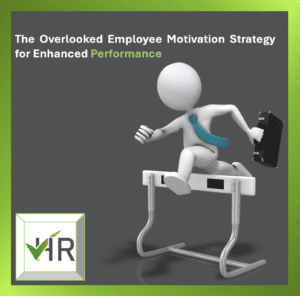The Overlooked Employee Motivation Strategy for Enhanced Performance
Employee motivation plays a crucial role in driving performance, engagement, and overall well-being within an organisation. Yet, many leaders still rely on traditional approaches, such as financial incentives or performance-based rewards, while overlooking a more effective and sustainable method.

Overcoming obstacles in the workplace: A representation of how cultivating self-driven motivation can empower employees to excel and engage fully in their roles
While these short-term tactics may give immediate results, they often lack the ability to encourage long-term commitment and satisfaction among employees.
To cultivate enduring motivation, leaders should focus on promoting self-driven extrinsic motivation. This approach enables employees to find personal significance in their work, even when tasks may not be inherently enjoyable.
Understanding Self-Driven Extrinsic Motivation
Employee motivation can generally be classified into two categories:
- Intrinsic Motivation: This occurs when individuals find inherent enjoyment and purpose in their work.
- Extrinsic Motivation: This is driven by external rewards, such as salaries, bonuses, promotions, or the desire to avoid negative consequences.
Whilst intrinsic motivation is ideal, not every task fulfils this principle. Similarly, although extrinsic motivation can be effective in the short term, it may lead to disengagement if employees feel pressured or controlled.
Self-driven extrinsic motivation bridges this gap by allowing employees to internalise external motivators. This transformation helps employees view tasks as opportunities for personal growth and meaningful contributions.
Initially driven by external factors, individuals eventually align their tasks with meaningful outcomes, taking the initiative to complete them without needing constant oversight.
Organisations that nurture self-driven extrinsic motivation benefit in several ways:
- Increased Ownership & Accountability: Employees are more proactive and responsible, reducing reliance on micromanagement.
- Higher Job Satisfaction & Well-Being: When employees see their work contributing to personal growth, their engagement and fulfilment improve.
- Lower Turnover Rates: Employees who recognise career progression and value in their roles are less likely to leave.
- Enhanced Innovation & Problem-Solving: A sense of personal investment leads to more creative solutions and willingness to take calculated risks.
Real-Life Examples of Self-Driven Extrinsic Motivation
Research indicates that employees who find personal value in their tasks are generally more satisfied and committed.
Illustrative scenarios
- Acquiring New Skills: A junior employee learns new project management software because their manager requests it. Over time, they realise it helps them stay organised and opens opportunities for greater responsibilities and promotions.
- Finding Meaning in Work: A nurse initially struggles with strict hospital protocols. As they internalise the importance of these procedures, they connect their role to saving lives, leading to greater job satisfaction.
- Aligning Tasks with Long-Term Goals: A middle manager views a complex project as just another task. However, upon recognising that leading the project will enhance their leadership skills and support their career growth, they embrace the challenge.
Steps for Leaders to Support Employee Motivation
Step 1: Understand What Motivates EmployeesLeaders should identify the key drivers of their employees’ motivation. Research highlights three fundamental needs vital for motivation: Autonomy, Relatedness, and Competence (ARC).
- Autonomy: The need for control over one’s actions and goals.
- Relatedness: The need for a sense of belonging and security in relationships.
- Competence: The need to master challenging tasks.
Understanding these needs allows leaders to better assess how they can be met.
Step 2: Ask Quality Questions and Listen
Regular one-on-one conversations can reveal what motivates employees and how they perceive their roles. Thoughtful questions help create an environment where employees feel valued and understood.
Step 3: Take Leadership Actions That Support Motivation
Leaders can enhance motivation by demonstrating behaviours that address employees’ basic needs. Research shows that when employees feel trusted to make their own decisions, their engagement and motivation increase. Instead of micromanaging, leaders should empower their teams and help them feel invested in their work.
The Role of Financial Incentives
While financial rewards like bonuses can motivate in the short term, they are not sustainable as long-term engagement strategies. Transparent and fair compensation is crucial; employees who feel treated equitably are more likely to be satisfied and engaged.
Building a Culture of Sustainable Motivation
Leaders who prioritise self-driven extrinsic motivation create teams that are more engaged, innovative, and committed to success. Cultivating a culture that meets employees’ universal needs requires understanding the principles of motivation and well-being, regularly assessing these needs, and engaging in actions that promote Autonomy, Relatedness, and Competence.
How are your leaders working to create an environment that meets the motivation and performance needs of your employees?
